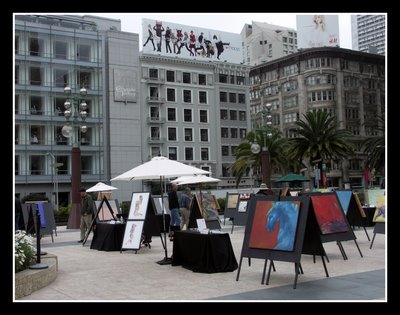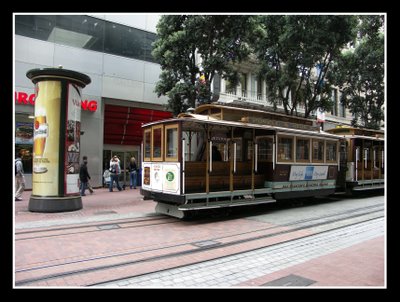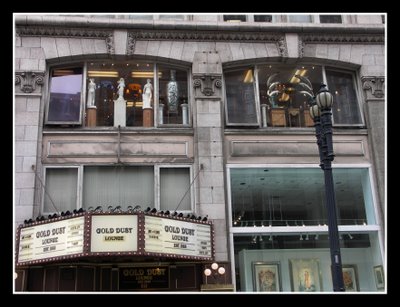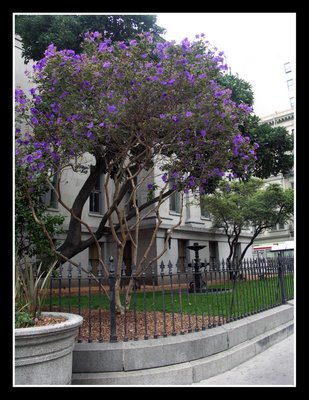Hallidie Plaza
Hallidie Plaza is located at Powell and Market Street. I always pass that area, but have never known it has a name before. The cable car station is right next to the plaza. Therefore there are lots of street vendors who are selling souvenirs to the tourists around the plaza.

Some street performers dancing around Hillidie plaza. Behind it, it's my favorite store -- Forever 21. (有装嫩之嫌 :P)
Bronze medallion
We walked around Hallidie plaza, watched the street performance, and browsed the souvenirs. Right while we were enjoying our moment, we suddenly remembered that we haven't seen one bronze medallion yet. So we started our search. We looked at the street corner, and went to check under each street vender's cart. We had no idea how it should look like and how big it should be. In my imagination, it's a small round yellow thing, kind of rusted and dusted, lying in some corner unnoticeable. We went to ask the street vender, hoping that they may have ever seen such a thing. Sadly no one has ever heard of it. We were about to give up, then I noticed there is this huge shiny thing lying in the middle of the walkway. I didn't even think that will be it because it's so big and shiny, and nicely engraved. It just looked too good to be true. But it has "Barbary Coast Trail" boldly and clearly carved on it, THAT'S IT -- our "Barbary Coast Trail" bronze medallion! 踏破铁鞋无觅处,得来全不费功夫!

The first bronze medallion we found,one arrow pointing to the way we come from, the other pointing to the way we need to go. Very clear instruction, excellent road guide, not like the rocks piled up by the rangers in the national park, this road sign will always give you a correct direction!
Andrew Hallidie
Andrew Hallidie is the father of the cable car. He promoted the first cable line in the world, the Clay Street Hill Railroad.
Andrew was born in London. His father held several patents for the manufacture of metal wire ropes. Hallidie had hurt his health through overwork, so he and his father visited California in 1852. Later his father returned to Britain but Hillidie remained in California. Andrew Hallidie mined, surveyed, blacksmithed, and built bridges. He became the first person to make wire rope in California. He built many suspension bridges in northern California. His cables were critical elements of suspension bridges, mine hauling systems, and an endless cable ropeway for industrial purposes which Hallidie patented in 1867. An important feature of the ropeway was a "grip wheel", a driving sheave with clips around its perimeter to keep the cable from slipping. Hallidie later used the grip wheel on the Clay Street Hill Railroad.
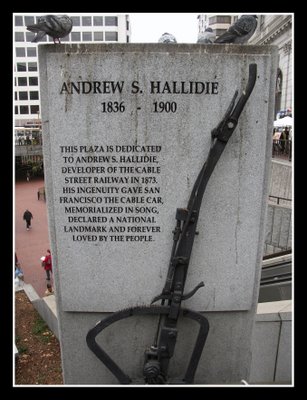
Various stories claim that Hallidie conceived of the idea of the cable railway while watching horses struggle to haul cars up Jackson Street, from Kearny to Stockton Street. The horses had to be whipped cruelly. They would sometimes slip and be dragged back down the hill. This may be true, but Hallidie took over an existing proposal for a cable railway from Benjamin H Brooks, who had not been able to find financing for his plan. In any event, Hallidie built a model cable railway and obtained financing from three partners. He received his first cable car-related patent on 17-Jan-1871. He had surveyed California Street for his line, but decided that it would be less expensive to build on Clay Street, and that Clay Street came closer to the peak of Nob Hill and so would offer a better demonstration of the system. Hallidie and his partners worked hard to sell stock in the line and did not have much success. The line and the grip which bears Hallidie's name were designed by engineer William E Eppelsheimer. The franchise demanded that a test run take place no later than 01-Aug-1873. The first test run actually took place early in the morning on 02-Aug-1873, but the city did not void the franchise. Most accounts say that the first gripman hired by Hallidie looked down the steep hill from Jones and refused to operate the car, so Hallidie took the grip himself and ran the car down the hill and up again without any problems. The line started regular service on 01-Sep-1873 and was a financial success. Hallidie's patents, managed by a Cable Railway Trust, made him rich.
>>next






